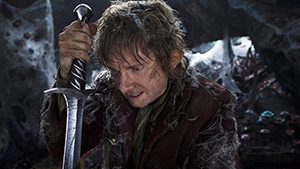I know, I know: it seems like I should write this letter to a member of the camera team, not someone from the editorial department. The Hobbit: An Unexpected Journey's use of high frame-rate photography--capturing images at 48 frames per second rather than the traditional 24--has generated almost as much pre-release buzz as Peter Jackson's return to Middle Earth itself.
So, let's just address that up front: how does it look? Not very good, I'm afraid. While it's true that the higher rate offers a stunning sharpness and clarity, it doesn't look very much like a movie. In fact, it looks a lot like video--video from 30 years ago. The combination of higher frames and 3D seems to have had the opposite effect Jackson intended: characters feel separated from the background, even when they're being shot on a real set; images appear overly bright in a way that recalls BBC theatre productions of the late 70s. The result is maddeningly distracting. Even though Jackson and his crew are using the same awesome New Zealand landscapes and locations as they did in the Lord of the Rings Trilogy, I couldn't get lost in them like I did with those films.
But this letter isn't supposed to be about frame rates and new technologies. I don't begrudge Jackson his desire to push cinema in new directions. It's entirely possible that ten years from now we'll look back on The Hobbit in the same way as The Jazz Singer: as an important (if flawed) foray into a new era of cinematic storytelling. And maybe we'll have a chuckle at all of our overwrought hand-wringing.
No, this letter is written out of concern for you, Andy, and your position as Apprentice Editor. I fear you may not be learning the essentials of your chosen trade.
It's not called "the invisible art" for nothing: an editor is tasked with trimming a film down to its essentials, making a piece cohesive both tonally and narratively--and doing it all in a manner that is completely transparent. That doesn't necessarily mean a good editor makes a short film. None of the films in the Rings trilogy can be accused of efficiency--but that's okay, because their expanded running times open them up and create a world that feels like it has existed for millennia, providing a very specific context for the epic adventure. In fact, the DVD extended cuts of the trilogy further proved this, as they tended to feel more coherent and better paced than their truncated theatrical siblings.
The Hobbit: An Unexpected Journey, though, suffers from the opposite problem. It feels like as if it has been edited not to tell the best story possible, but to match a predetermined running time. A running time the original novel's slight story just cannot support.
Where The Fellowship of the Ring had a prologue that sets up the arc of all three films, here we are given two prologues--one detailing the rise and fall of Middle Earth's last great Dwarven kingdom, and one that reintroduces Bilbo and Frodo Baggins (which exists primarily to transfer the audience's goodwill from the original trilogy). The next hour then introduces a younger Bilbo (Martin Freeman, properly flustered), Gandalf (Ian McKellan, charming and commanding as ever) and the 13 Dwarves (each given his own individual introduction) that enlist Bilbo on their quest to win back their kingdom from the dragon Smaug. Everything - from the overlong dinner sequence to the two (yes, two!) unending songs - feels like a sort of filmic stall tactic.
Where some complained that The Return of the King was the film that refused to end, The Hobbit: An Unexpected Journey is the film that refuses to start.
This approach infects most of the film. Action scenes are dragged out until their relevance to the story is forgotten. Characters are introduced haphazardly in scenes that last too long and have only the most tangential relationship to the main plot. The tone is wildly uneven as the lighter Tolkien story collides with the self-serious epic tones that I suppose are meant to make this more of a piece with the grandiosity of Lord of the Rings. It never really comes together.
Of course, you may be in a better position to know if this will play out over the new trilogy's nearly 9-hour running time. Being the first part of three, The Hobbit: An Unexpected Journey may suffer for lack of revealing the grand plan Jackson has envisioned. Here's hoping.
But I don't think that's what's keeping The Hobbit: An Unexpected Journey from working on its own terms. There are great moments that come directly from the novel that work marvellously because they have been very clearly directed and, yes, edited for maximum storytelling impact. The battle of the stone giants is short but awe-inspiring. An encounter with three cave trolls finds the right balance of humour and menace. And, finally, there is the famous game of riddles between Bilbo and Gollum (Andy Serkis, perfect again). A scene that take sup 30 pages of Tolkien's book has been worked into a tight, tense 10 minutes that is the highlight of the entire film, proving that a mastery of the fundamentals of filmmaking can overcome the highest of frame rates. When you look back at your apprenticeship, these are the scenes that you should study.
Wow, this letter is close to three times the length of what we usually write here. Maybe The Hobbit: An Unexpected Journey inspired me more than I realized.
Long-windedly yours,
Casey






